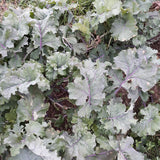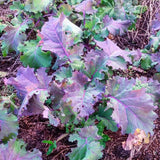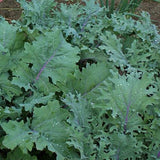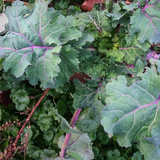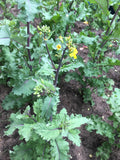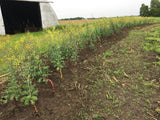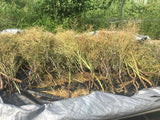Dutch-Siberian Napus Kale Grex
Brassica napus
From our friends at Experimental Farm Network:
We love Brassica napus kales, from the common 'Red Russian' or 'Ragged Jack' to the uncommon Dutch heirloom 'Blauwe Groninger' (our favorite). Many of these are known as 'Siberian' kales, and they are incredibly cold hardy. Brassica napus is the same species as rutabaga, believed to be the result of an ancient hybridization between a cabbage (Brassica oleracea) and a turnip (Brassica rapa). In general, the napus kales are more tender, with a less bitter, more mustardy flavor than the rest of the kales (like standard "curly kale", 'Tuscan Black', or "purple kale"), which are the same species as cabbage. We are excited to be offering this "grex" (freely interbreeding diverse population) which contains a wide variety of delicious 'Siberian'/'Red Russian' kales — from a population originally released by Frank Morton of Wild Garden Seeds — crossed with two strains of 'Blauwe Groninger' ("Blue from Groningen") for even more flavor and hardiness (one strain is the 'Willem's Blauwe Groninger' we've been growing for many years, a highly uniform population, and the other the 'Groninger Blue Collard-Kale' sold by Nichols Garden Nursery, which was introduced to them by our friend Dr. Carol Deppe, after bouncing around Canada for a few decades and acquiring less uniformity). A broad population like this makes it easy to develop your own new variety or landrace, perfectly adapted to your growing conditions. It's also just plain fun to grow a grex like this because you never know what you're going to get! In general, napus kales don't hold up in storage very long (which is why they are rarely found at markets), unless the bottoms are cut and kept in water, but they are wonderful for home use. Finally, these kales are not only great for cooking, but excellent for raw use, especially the young leaves.
Seeds per pack: ~80
Planting / harvesting notes
Direct seed 1/4 inch deep in garden or field, spring through late summer, or transplant in healthy plant starts. Plant spacing could range from 3-16 inches, depending on what you are going for. Prefers full sun.
Seed keeping notes
Isolate by 1/2 mile from other flowering members of B. napus, including Rapeseed, Swedes, Rutabagas, Siberian Kale, and Canola to avoid unwanted cross-pollination. Allow seed pods to turn brown and dry before seed harvest. Protect from birds.








